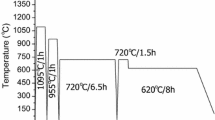Abstract
The effect of heat treatments on the creep–rupture properties was investigated on a wrought Ni–Cr heat-resistant alloy at 973 K. Short-time aging (aging for 3.6 ks (1 h) at 973 K) was made on the solution-treated specimens with different grain sizes. The fine-grained specimen (the grain diameter, d = 45.2 μm) produced by short-time solution treatment exhibited almost the same rupture life and superior creep ductility as those of the medium-grained specimen (d = 108 μm) produced by normal solution treatment. The fine-grained specimen and medium-grained specimen showed the longer rupture life compared with the specimen with recommended aging. The principal strengthening of specimens was attributed to the precipitation hardening by γ′ phase particles. The fine-grained specimen had the highest hardness, and the increase of the hardness was observed in both the fine-grained and the medium-grained specimens during creep at 973 K. However, coarse-grained specimen (d = 286 μm) with high-temperature long-time solution treatment exhibited significantly short rupture life owing to insufficient precipitation hardening after the short-time aging and during creep. Ductile intergranular fracture with dimples occurred in the fine-grained specimen, while brittle intergranular fracture was observed in the medium-grained specimen and in the specimen with recommended aging. Both transgranular fracture and brittle intergranular fracture were observed in the coarse-grained specimen. A simple heat treatment composed of short-time solution treatment and short-time aging is applicable to high-temperature components of wrought Ni–Cr alloys.






Similar content being viewed by others
References
Donachie M, Donachie S (2002) Superalloys, 2nd edn. ASM International, Materials Park, Ohio
Wisniewski A, Beddoes J (2009) Mater Sci Eng A 510–511:266
Raymond EL (1967) Trans Metall Soc AIME 239(9):1415
Venkiteswaran PK, Taplin DMR (1974) Met Sci 8(1):97
Arbel A, Pande CS (1988) J Mater Sci 23(9):3375. doi:10.1007/BF00551321
Jahazi M, Mashreghi AR (2002) Mater Sci Technol 18(4):458
Sims CT, Hagel WC (1972) The superalloys. Wiley, New York
Sims CT, Stoloff NS, Hagel WC (1987) Superalloys II. Wiley, New York
Garofalo F, Domis W, von Gemmingen F (1964) Trans Met Soc AIME 230(10):1460
Tanaka M, Kato R, Ito Y, Kayama A (2000) Z Metallkd 91(5):429
Lagneborg RJ (1969) J Iron Steel Inst 207(11):1503
Barrett CR, Lytton JL, Sherby OD (1967) Trans Met Soc AIME 239(1):170
Evans HE (1984) Mechanisms of creep fracture. Elsevier Applied Science Publishers, London
McElroy RJ, Szkopiak ZC (1972) Int Metall Rev 17:175
McQueen HJ (1977) Metall Trans A 8A(6):807
Hausselt JH, Nix WD (1977) Acta Metall 25(6):595
Tanaka K, Mori T, Nakamura T (1970) Philos Mag 21(170):267
Langdon TG, Vastava RB (1982) ASTM STP 765. ASTM, Philadelphia, p 435
Tanaka M, Iizuka H (1985) J Mater Sci 20(10):3750. doi:10.1007/BF01113784
Iizuka H, Tanaka M (1986) J Mater Sci 21(2):611. doi:10.1007/BF01145531
Koul AK, Gessinger GH (1983) Acta Metall 31(7):1061
Iizuka H, Tanaka M (1986) J Mater Sci 21(8):2803. doi:10.1007/BF00551493
Tanaka M, Miyagawa O, Sakaki T, Iizuka H, Ashihara F, Fujishiro D (1988) J Mater Sci 23(2):621. doi:10.1007/BF01174696
Hong HU, Nam SW (2002) Mater Sci Eng A 332:255
Kotval PS, Venables JD, Calder RW (1972) Metall Trans 3(2):453
Acknowledgements
The authors thank Dr. D. Fujishiro, Former Director of Nittan Valve Company, for supplying Ni–Cr alloy used in this study. They also thank Prof. Z. Nakagawa and Mr. K. Sasaki of Center for Geo-Environmental Science, Akita University for chemical analysis by SEM-EDS, and Mr. T. Moronaga of Electronics Division of Kobelco Research Institute Inc. for microstructural and chemical analyses using TEM-EDS.
Author information
Authors and Affiliations
Corresponding author
Rights and permissions
About this article
Cite this article
Tanaka, M., Kato, R. The effect of heat treatments on the creep–rupture properties of a wrought Ni–Cr heat-resistant alloy at 973 K. J Mater Sci 45, 4029–4035 (2010). https://doi.org/10.1007/s10853-010-4481-9
Received:
Accepted:
Published:
Issue Date:
DOI: https://doi.org/10.1007/s10853-010-4481-9



